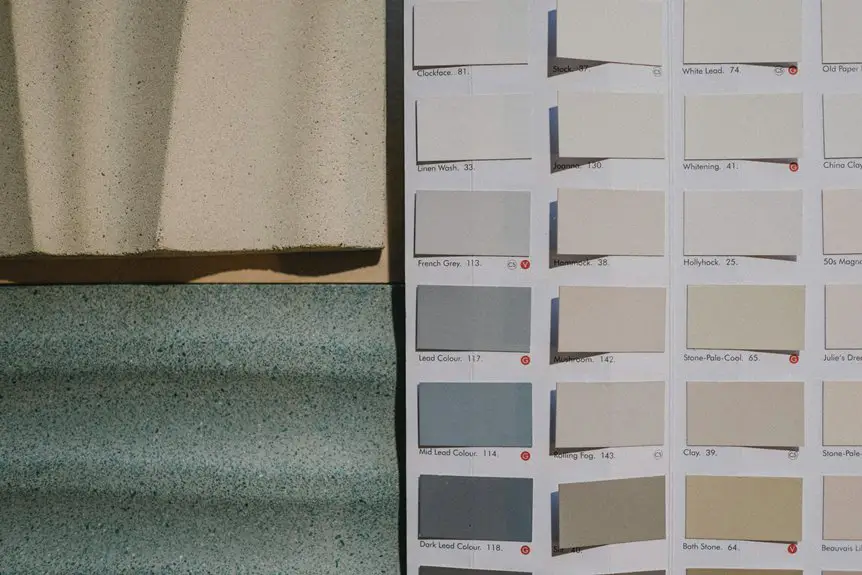If you need strong, abrasion-resistant material at a lower cost, polyamide is a smart choice with good heat stability but absorbs moisture. On the other hand, polyurethane offers superior flexibility, chemical and UV resistance, and better water resistance, ideal for heavy-load or outdoor use. While polyamide excels in rigidity, polyurethane handles environmental stress better. Choosing depends on your project’s durability, flexibility, and exposure needs. Understanding these differences can help you pick the perfect fit.
Table of Contents
Key Takeaways
- Polyamide offers higher tensile strength and abrasion resistance, while polyurethane provides superior elasticity and impact resistance.
- Polyamide has better thermal resistance with melting points of 220-270°C, versus polyurethane’s lower tolerance of 90-150°C.
- Polyurethane generally exhibits higher chemical and UV resistance compared to polyamide, which absorbs moisture and weakens over time.
- Polyamide is more cost-effective and widely available, whereas polyurethane may have higher upfront costs but greater long-term durability.
- Polyamide suits applications needing strength and rigidity, while polyurethane is ideal for flexibility, chemical resistance, and environmental exposure.
What Is Polyamide?
Polyamide, often known as nylon, is a type of synthetic polymer widely used in textiles and plastics. When you choose polyamide, you get a material celebrated for its strength, durability, and resistance to abrasion.
It’s a versatile polymer made through polymerization of monomers containing amide groups. You’ll often find it in clothing, ropes, and automotive parts because it handles wear and tear exceptionally well.
Polyamide fibers absorb moisture, so your fabrics feel comfortable and breathable. Plus, it resists chemicals and heat to some extent, making it reliable for various applications.
If you need something lightweight yet tough, polyamide fits the bill perfectly. Understanding these properties helps you decide when polyamide suits your project or product needs without confusion.
What Is Polyurethane?
You’ll find polyurethane is a versatile polymer made from organic units joined by carbamate links.
It’s used in everything from foam cushions to coatings and adhesives. Understanding its chemical makeup helps you see why it’s so widely applied across industries.
Chemical Composition Overview
Although it might seem complex at first, understanding polyurethane’s chemical makeup can help you appreciate its versatility.
Polyurethane is a polymer composed mainly of organic units joined by carbamate (urethane) links. It forms through the reaction of polyols and diisocyanates, creating a wide range of materials from flexible foams to rigid plastics.
Here’s a quick breakdown:
- Polyols – These are molecules with multiple hydroxyl groups, acting as one building block.
- Diisocyanates – Reactive compounds that link with polyols to form the polymer chain.
- Catalysts and additives – These control the reaction rate and final properties.
- Cross-linking – This process determines the density and rigidity of the final product.
Knowing these basics helps you understand why polyurethane adapts to so many uses.
Common Applications
Understanding polyurethane’s chemical structure reveals why it suits so many purposes.
You’ll find it in foam cushions, insulation panels, and even coatings because it offers excellent flexibility and durability. When you need lightweight yet strong materials, polyurethane fits the bill, especially in automotive parts and footwear soles.
It also excels as a sealant or adhesive, protecting surfaces from moisture and wear. If you’re working with furniture or mattresses, polyurethane foam provides comfort and support.
Plus, when you want a protective finish that resists chemicals and abrasion, polyurethane coatings are your go-to.
Its versatility means you’ll encounter polyurethane in construction, electronics, and everyday products, making it a material that adapts to your needs efficiently.
Chemical Structure and Composition
You’ll notice that polyamide and polyurethane differ in their molecular chains and functional groups.
Understanding these differences helps you grasp how each polymer forms through distinct polymerization processes.
Let’s explore what makes their chemical structures unique.
Molecular Chain Differences
When comparing polyamide and polyurethane, their molecular chains reveal key differences that affect their properties and applications. You’ll notice these distinctions mainly in how their chains are structured and linked.
- Polyamide chains consist of repeating amide groups, creating strong hydrogen bonds.
- Polyurethane chains combine urethane linkages formed by reacting isocyanates with polyols.
- Polyamide’s chains are typically more crystalline, giving them higher melting points.
- Polyurethane chains are more flexible due to segmented soft and hard blocks, enhancing elasticity.
Understanding these molecular chain differences helps you predict how each material behaves under stress, temperature changes, and wear, which is vital when choosing the right polymer for your project or product.
Functional Groups Comparison
Although polyamide and polyurethane share some similarities as polymers, their functional groups differ markedly, shaping their chemical behavior and applications.
Polyamides contain amide groups (-CONH-) formed by the reaction between carboxylic acids and amines, giving them strong hydrogen bonding capabilities. This results in high tensile strength and thermal stability.
Polyurethanes, on the other hand, feature urethane groups (-NHCOO-) created from isocyanates reacting with alcohols. These groups impart flexibility and resistance to abrasion and impact.
When you compare them, polyamide’s amide bonds lead to rigidity and moisture absorption, while polyurethane’s urethane linkages offer elasticity and chemical resistance.
Understanding these functional groups helps you predict how each polymer performs in specific environments, making it easier to choose the right material for your project.
Polymerization Processes Explained
The differences in functional groups between polyamide and polyurethane stem directly from their distinct polymerization processes. When you understand these processes, you’ll see why their properties vary so much.
- Polyamide forms through condensation polymerization, where diamines react with dicarboxylic acids, releasing water.
- Polyurethane forms via addition polymerization between polyols and diisocyanates, creating urethane linkages without byproducts.
- Polyamide’s amide bonds give it strong hydrogen bonding, enhancing strength and thermal resistance.
- Polyurethane’s flexible urethane bonds allow for varied hardness and elasticity.
Knowing these key steps helps you grasp why polyamides are tougher, while polyurethanes offer more versatility in applications.
Mechanical Properties Comparison
Since you’re choosing between polyamide and polyurethane, understanding their mechanical properties is essential. Polyamide (nylon) offers excellent strength, rigidity, and abrasion resistance, making it ideal for demanding applications. Polyurethane, on the other hand, provides superior elasticity and impact resistance, perfect if flexibility matters most. Here’s a quick mechanical properties comparison to help you decide:
| Property | Polyamide (Nylon) | Polyurethane |
|---|---|---|
| Tensile Strength | High (strong and stiff) | Moderate (flexible) |
| Elongation at Break | Low to moderate (less stretch) | High (very stretchable) |
| Impact Resistance | Moderate | High |
| Abrasion Resistance | Excellent | Good |
This table should clarify which polymer suits your project’s mechanical demands best.
Thermal Resistance and Stability
When you need materials that can handle varying temperatures, understanding thermal resistance and stability becomes essential.
Polyamide and polyurethane behave differently under heat, so picking the right one depends on your application.
- Polyamide offers higher melting points, typically around 220-270°C, making it suitable for high-temperature uses.
- Polyurethane has a lower thermal tolerance, usually up to about 90-150°C, limiting its use in extreme heat.
- Polyamide maintains mechanical strength better at elevated temperatures, which helps in demanding environments.
- Polyurethane provides good flexibility but can degrade faster when exposed to sustained heat or thermal cycling.
Resistance to Chemicals and Environmental Factors
Understanding how polyamide and polyurethane handle heat gives you a good idea of their durability, but you’ll also want to evaluate how they react to chemicals and environmental factors. Polyamide tends to absorb moisture, which can weaken it over time, while polyurethane resists water better and holds up well against oils and solvents. Both materials face challenges with UV exposure, but polyurethane usually offers better resistance.
| Factor | Polyamide |
|---|---|
| Water Resistance | Moderate (absorbs moisture) |
| Oil Resistance | Moderate |
| Solvent Resistance | Moderate |
| UV Resistance | Low to Moderate |
| Chemical Resistance | Variable, less resistant |
| Factor | Polyurethane |
| Water Resistance | High |
| Oil Resistance | High |
| Solvent Resistance | High |
| UV Resistance | Moderate to High |
| Chemical Resistance | Generally high |
Common Industrial Applications
Industries rely on both polyamide and polyurethane for their unique properties and versatility. When choosing between them, you’ll find each excels in specific applications.
- Automotive parts: Polyamide is your go-to for fuel lines and engine components due to its heat resistance, while polyurethane fits well in seat cushions and interior panels for comfort and durability.
- Footwear: Polyamide offers strength for shoe uppers, whereas polyurethane provides flexible soles.
- Electrical components: Polyamide insulates wires effectively, and polyurethane seals protect electronics from moisture.
- Coatings and adhesives: Polyurethane delivers tough, weather-resistant finishes, ideal for industrial surfaces.
Knowing these uses helps you select the right material that matches your project’s demands without compromising performance.
Cost and Availability Considerations
Choosing the right material goes beyond matching properties to applications; cost and availability often play a big role in your decision.
Polyamide generally costs less than polyurethane, making it a budget-friendly option if you’re managing tight financial constraints. It’s widely produced and readily available, so sourcing it typically won’t delay your project.
On the other hand, polyurethane tends to be pricier due to its versatile formulations and specialized uses. While it might cost more upfront, its durability can save you money over time.
Availability of polyurethane can vary depending on the specific type you need, so you may face longer lead times. When planning your procurement, consider both immediate costs and supply chain reliability to avoid surprises that could impact your project timeline or budget.
Factors to Consider When Choosing Between Polyamide and Polyurethane
When weighing polyamide against polyurethane, you’ll want to focus on how each material’s properties align with your specific needs.
Both offer unique benefits, but your choice depends on the application. Consider these factors:
- Durability Needs – Polyamide excels in abrasion resistance, while polyurethane offers superior flexibility.
- Environmental Exposure – Polyurethane handles chemicals and UV exposure better than polyamide.
- Load and Stress – For heavy loads and impact, polyurethane often performs better due to its elasticity.
- Cost Constraints – Polyamide is generally more affordable, but long-term value depends on usage conditions.
Frequently Asked Questions
Can Polyamide and Polyurethane Be Safely Recycled Together?
You want to recycle safely, efficiently, responsibly. But you can’t recycle polyamide and polyurethane together easily—they have different properties and melting points. So, you should separate them to guarantee proper recycling and avoid contamination.
Which Material Is More Environmentally Friendly to Produce?
You’ll find producing polyurethane generally uses less energy and emits fewer greenhouse gases than polyamide. So, if you’re aiming for a lower environmental impact, polyurethane is usually the more eco-friendly choice to manufacture.
Are There Any Health Risks Associated With Handling These Materials?
When handling these materials, you should wear gloves and work in ventilated areas. They can release harmful fumes or cause skin irritation, so taking precautions helps you avoid respiratory issues and allergic reactions.
How Do Polyamide and Polyurethane Perform in Food Contact Applications?
When it comes to food contact, you’ll find polyamide is like a trusty shield—resistant and safe, while polyurethane can be a bit trickier, sometimes requiring careful formulation to meet strict safety standards. Always check certifications!
Can These Materials Be 3D Printed Effectively?
You can 3D print both materials effectively. Polyamide offers strong, flexible parts ideal for functional prototypes, while polyurethane provides excellent elasticity and durability. Just choose the right printer settings to get the best results.
- Will 100% Cotton Percale Wrinkle? The Honest Truth - July 15, 2025
- Why Do Toenails Tear Percale Sheets and How to Prevent It - July 15, 2025
- Why Is Percale Considered a Superior Sheet? - July 15, 2025







